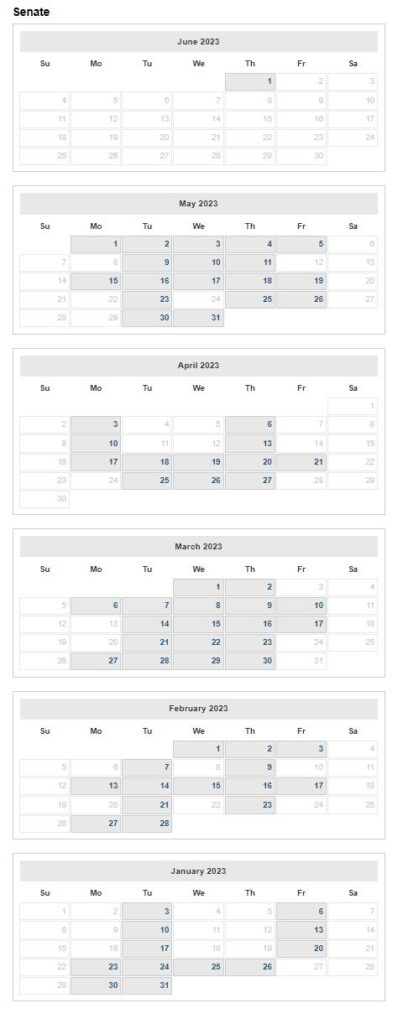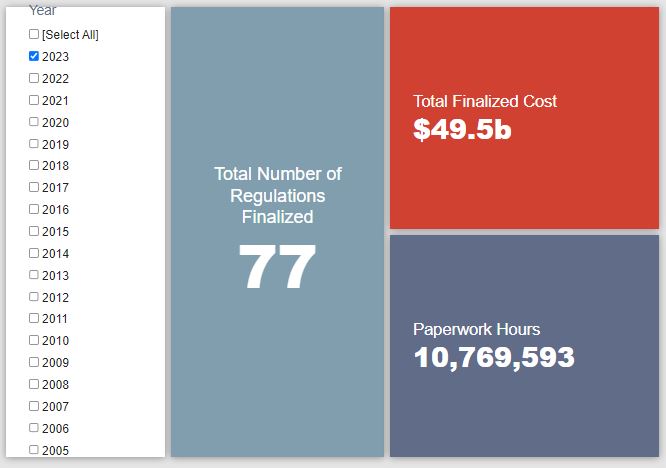Week in Regulation
June 5, 2023
Energy Rules and Massive New Paperwork Highlight Busy Week
With 18 rulemakings containing some measurable economic impact, last week was one of the more active weeks in the Federal Register in recent memory. Beyond the sheer volume of actions, however, there were multiple notable items. A pair of Department of Energy (DOE) efficiency standards rules contributed most of the costs while a Food and Drug Administration (FDA) proposal included a sizeable amount of new paperwork. Across all rulemakings, agencies published $2 billion in total costs and added 94.1 million annual paperwork burden hours.
REGULATORY TOPLINES
- Proposed Rules: 31
- Final Rules: 53
- 2023 Total Pages: 36,373
- 2023 Final Rule Costs: $49.5 billion
- 2023 Proposed Rule Costs: $312.5 billion
NOTABLE REGULATORY ACTIONS
The most significant rules from a cost perspective were two sets of efficiency standards out of DOE addressing consumer pool heaters and electric motors. Both rules bring approximately $700 million in total costs, for a combined total of $1.4 billion. What is perhaps most interesting is that the electric motors rule comes in the form of a “direct final rule” that has a companion proposed rule that will become operative if DOE “receives an adverse comment and determines that such comment may provide a reasonable basis for withdrawing the direct final rule.” The direct final rule is a result of a “Joint Recommendation” that included input across a broad swath of stakeholders and that DOE believes justifies putting forward the standards in this form.
The most significant rulemaking on paperwork was the FDA proposed rule regarding “Medication Guides: Patient Medication Information.” The proposal seeks to require the creation and distribution of Patient Medication Information (PMI) notices that “would be a one-page document with standardized format and content…intended to improve public health by providing patients with clear, concise, accessible, and useful written prescription drug product information.” FDA currently estimates total costs of roughly $162 million, but where the rulemaking really expands burdens is in the paperwork section, with a total of 86.8 million hours. Most of this will come from prescription dispensers providing the PMI notice to patients. FDA estimates that the actual act will only take one minute, but when it applies to the “4.3 billion prescriptions annually and 3 million transfusions annually,” it adds up to 86,060,000 hours.
TRACKING THE ADMINISTRATIONS
As we have already seen from executive orders and memos, the Biden Administration will surely provide plenty of contrasts with the Trump Administration on the regulatory front. And while there is a general expectation that the current administration will seek to broadly restore Obama-esque regulatory actions, there will also be areas where it charts its own course. Since the AAF RegRodeo data extend back to 2005, it is possible to provide weekly updates on how the top-level trends of President Biden’s regulatory record track with those of his two most recent predecessors. The following table provides the cumulative totals of final rules containing some quantified economic impact from each administration through this point in their respective terms.
![]() For the first time in a while, much of the week’s action actually did come on the final rules side. As such, the Biden to-date tallies shot up noticeably. Costs increased by nearly $1.9 billion, mostly due to the DOE rules discussed above. Paperwork increased by 7.1 million, with a Consumer Financial Protection Bureau rule providing most of that total. Both of the other administrations, however, were almost entirely stagnant. The only actions across either were a handful of airworthiness directives under Obama that added up to a grand total of $6 million in costs.
For the first time in a while, much of the week’s action actually did come on the final rules side. As such, the Biden to-date tallies shot up noticeably. Costs increased by nearly $1.9 billion, mostly due to the DOE rules discussed above. Paperwork increased by 7.1 million, with a Consumer Financial Protection Bureau rule providing most of that total. Both of the other administrations, however, were almost entirely stagnant. The only actions across either were a handful of airworthiness directives under Obama that added up to a grand total of $6 million in costs.
THIS WEEK’S REGULATORY PICTURE
This week, the period to take up 2022 rules with expedited consideration under the Congressional Review Act (CRA) came to a close.
 Source: Image pulled from Congress.Gov “Days in Session” Page
Source: Image pulled from Congress.Gov “Days in Session” Page
If counting days on the congressional calendar is your idea of fun, then the CRA must hold a special place in your heart. To that end, though, this past week marked an important threshold for those who track such developments. As of June 1, the “look-back” period under the CRA to bring an expedited vote on regulations from late 2022 ended. Here’s why that is.
The Congressional Research Service (CRS) helpfully provided a full rundown of all that you would care to know about the CRA process here. Basically, under the CRA, the Senate has 60 “session days” from when a rule is transmitted to it (usually on or around the day a rule is published) to take up a joint resolution of disapproval against the rule without having to worry about a filibuster setting the effective threshold at 60 votes. The “look-back” provision allows for consideration of rules published at the end of the preceding Congress (which may or may not involve a different presidential administration).
For procedural purposes, those “look-back” rules are considered “transmitted” on the 15th session day of the new Congress. That would be February 3 in this instance. From there, it’s a matter of getting to 60 session days after that point. In this case, June 1 was Day 60. As a perhaps somewhat fitting conclusion to this window, the Senate took up and passed the CRA resolution regarding the Biden Administration’s student loan forgiveness program, which now heads to Biden’s desk to be summarily vetoed.
While this marks the end of the “look-back” consideration window, it hardly spells the end of CRA votes in this Congress. The Senate passed a series of CRA resolutions that included the Biden “Public Charge” rule and a trio of rules regarding endangered species regulations. It is likely just a matter of when the House takes those up, since of course, there is no filibuster to worry about in that chamber. Additionally, the CRA is still operative on an ongoing basis as rules continue to flow out of the current administration, but their respective “windows” are contingent upon their exact “transmission” date at this point.
Thus, while it is not the full endpoint of CRA action, it is worth taking stock of the current record. President Biden has already officially logged three vetoes of CRA resolutions. With the aforementioned resolution on the student loan rule and one on a rule regarding emissions standards for heavy-duty vehicles en route to his desk, that will bring the total to five. Assuming the House takes up and passes the other four discussed above, that will add up to nine. By way of comparison, President Obama had five CRA vetoes and President Trump had just one. With a House Republican majority eager to voice its disapproval of Biden rulemakings and the potential for Senate consideration under a discharge petition, that Biden veto total may continue to grow.
TOTAL BURDENS
Since January 1, the federal government has published $362.1 billion in total net costs (with $49.5 billion in new costs from finalized rules) and 147.3 million hours of net annual paperwork burden increases (with 10.8 million hours in increases from final rules).











